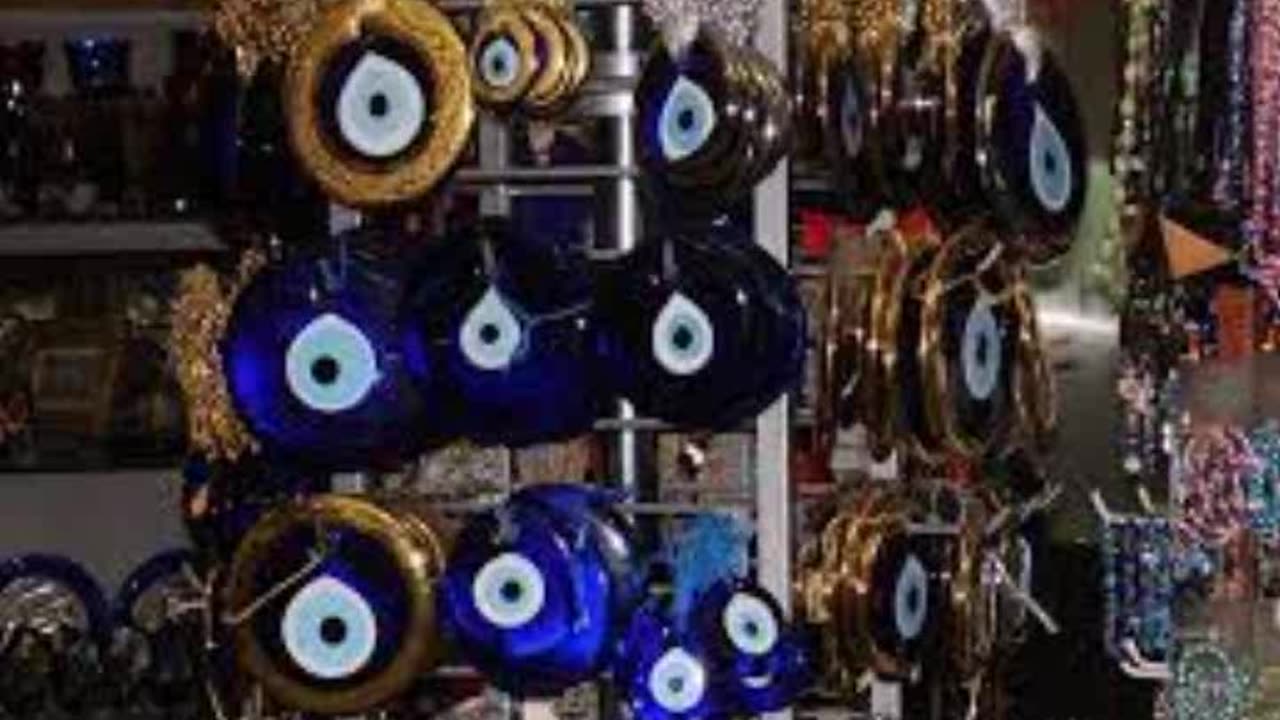Premium Only Content

Evil Eye
https://solitarypaganism.com/witchcraft/evil-eye/
The causing of illness, misfortune, calamity and death by the looks of strangers and by envious looks, amulets and incantations ward the danger off.
The evil eye exists around the world, dating to ancient times.
The oldest recorded references to the evil eye appear in the cuneiform texts of the Sumerians, Babylonians, and Assyrians, about 3000 b.c.e.
The ancient Egyptians believed in the evil eye and used eye shadow and lipstick to prevent it from entering their eyes or mouths.
The Bible makes references to it in both the Old and New Testaments.
It is among ancient Hindu folk beliefs.
Evil-eye superstitions have remained strong into modern times, especially in Mediterranean countries such as Italy and in Mexico and
Central America.
There are two kinds of evil eye: deliberate and involuntary.
Most cases of evil eye are believed to occur involuntarily; the person casting it does not mean to do it and probably isn’t even aware of it.
No revenge is sought for this hazard.
The malevolent, deliberate evil eye is called “overlooking” and is a form of witchcraft that can bring about misfortune or catastrophe: illness, poverty, injury, loss of love, even death.
Witches were said to give anyone who crossed them the evil eye and to use it to bewitch judges from convicting them.
The involuntary evil eye typically occurs when someone, especially a stranger, admires one’s children, livestock or possessions, or casts a lingering look on anyone.
Unless immediate precautions are taken, the children get sick, the animals die, the possessions are stolen or good fortune in business turns sour.
If the evil eye cannot be warded off, the victim must turn to an initiate—usually an older woman in the family—who knows a secret cure.
Besides envious glances, the evil eye comes from strangers in town, or anyone who has unusual or different-colored eyes—a blue-eyed stranger in a land of brown-eyed people, for example.
Some unfortunate souls are said to be born with permanent evil eye, laying waste to everything they see.
High-ranking people such as noblemen or clergy sometimes are believed to be afflicted like this. Pope Pius IX (1846–78) was branded as having he evil eye shortly after his investiture as Pope in 1869.
Driving through Rome in an open car, he glanced at a nurse holding a child in an open window.
Minutes later, the child fell to its death, and from then on, it seemed that everything the Pope blessed resulted in disaster.
Pope Leo XIII (1878–1903) was also said to possess the mal occhio, as the evil eye is known in Italy.
The evil eye is most likely to strike when one is happiest; good fortune, it seems, invites bad fortune.
Small Hand positions to ward off the evil eye children and animals are especially vulnerable.
In many villages, it is considered unwise to show children too much in public or to call attention to their beauty.
Likewise, it is not advisable to display possessions or brag about successes.
In 19th-century Ireland, animals who were under the influence of the evil eye were said to have been “blinked.”
In order to save such animals, local wise women were sought for ritual cures.
The primary defense against the evil eye is an amulet, which may be fashioned from almost any kind of material.
Common shapes are frogs and horns, the latter of which suggests both the powerful Mother Goddess (a bull is her consort) and the phallus.
Another popular amulet is the “fig,” a clenched fist with thumb thrust between the index and middle fingers, which also suggests a phallus.
The roots of the phallus amulet go back to the ancient Romans and their phallic god, Priapus.
Another name for him was Fascinus, from fascinum, which means “witchcraft”; the evil eye is sometimes called “fascination.”
Romans employed phallic symbols as their protection against the evil eye. In Italy, it is still common for men to grab their genitals as a defense against the evil eye or anything unlucky.
The ancient Egyptians used an eye to fight an eye. The udjat eye, also called the Eye of God and Eye of Horus, appears on amulets, pottery and in art, warding off the forces of darkness.
Other defenses include bells and red ribbons tied to livestock, horse harnesses and the underwear of children, which divert the attention of the evil eye.
Gardens are surrounded by protective jack beans.
Other plants act as amulets—the shamrock in Ireland and garlic in Greece.
In Hindu lore, barley, a universal remedy supplied by the gods and the symbol of the thunderbolt of Indra, god of war, thunder and storms, will avert the evil eye.
Without an amulet, quick action is important when the evil eye strikes. One should make gestures such as the “fig” or “horns” (holding up the index and little finger).
Spitting is a powerful remedy, a hold-over from the ancient Romans and Greeks.
Cures for the evil eye usually involve reciting secret incantations, which typically are passed on from mother to daughter within a family.
In Italy, an initiate diagnoses the evil eye and performs the cure with a bowl of water, olive oil and, occasionally, salt.
A few drops of oil are dropped into the water (sometimes salted).
The oil may scatter, form blobs or sink to the bottom.
These formations are interpreted to determine the source of the attack.
The initiate drops more oil into the water while reciting incantations and making the sign of the cross on the forehead of the victim.
If that fails, the victim is sent to a sorceress for further treatment.
-
 9:21
9:21
asolitarypagan.com
1 year agoMaking Herbal Salves
1.73K -
 LIVE
LIVE
Matt Kohrs
12 hours agoTesla Pops on News, Bitcoin Pushes Higher & Nvidia Earnings || The MK Show
1,542 watching -
 35:19
35:19
BonginoReport
3 hours agoDeep State Wants WW3 Before Trump Takes Office (Ep.87) - 11/18/24
28.4K65 -
 LIVE
LIVE
Jeff Ahern
1 hour agoMonday Madness with Jeff Ahern (6am Pacific)
561 watching -
 2:00:55
2:00:55
AP4Liberty
2 hours ago $6.12 earnedMusk's Dual Role in Trump's Transition Team and Policy Influence
19.5K3 -
 6:33:53
6:33:53
MissesMaam
12 hours agoRumblers Stranded Again! | Sons of the Forest 💚✨
47K6 -
 16:03
16:03
DeVory Darkins
1 day ago $38.03 earned"Shut The F**K UP!" Charles Barkley EXPLODES As DEMS MELTDOWN over Trump
85.7K346 -
 4:44:04
4:44:04
Akademiks
13 hours agoDiddy is RUNNING The Jail! Feds Fear He's Unstoppable even behind Bars! Drake Revenge Era?
116K28 -
 5:26:52
5:26:52
Fed Reacts
11 hours agoReaction To Twitch Adpocolypse, Thots, Debating Blacks & Liberals!
76K15 -
 2:12:41
2:12:41
TheSaltyCracker
14 hours agoMSM Implodes After Trump Win ReeEEeE Stream 11-17-24
259K582